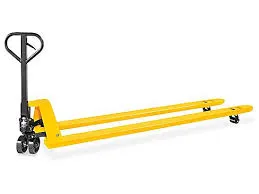


Understanding Small Electric Wire Rope Hoists A Comprehensive Guide
Small electric wire rope hoists have become an essential tool in various industries due to their efficiency, convenience, and safety. These devices are designed to lift and move heavy loads in a controlled manner, making them invaluable in construction sites, warehouses, and manufacturing facilities. This article explores the functionality, benefits, applications, and maintenance of small electric wire rope hoists.
What Are Small Electric Wire Rope Hoists?
A small electric wire rope hoist is a compact lifting device powered by electricity that utilizes a wire rope to lift heavy objects. The hoist typically consists of a motor, a drum that winds the wire rope, and a pulley system that guides the rope. These hoists come in various capacities, usually ranging from a few hundred pounds to several tons, making them versatile for different lifting needs.
Functionality
The operation of small electric wire rope hoists is relatively straightforward. When powered on, the electric motor rotates the drum, causing the wire rope to wind around it. The load attached to the free end of the wire rope is lifted as the drum turns. Most electric wire hoists include a control mechanism that allows operators to raise or lower the load with precision. This mechanized lifting is controlled through a pendant control or a remote control panel, ensuring that workers can operate the hoist from a safe distance.
Benefits
1. Efficiency Electric wire rope hoists operate much faster than manual hoisting systems. They can significantly reduce the time required to lift heavy loads, thereby increasing productivity.
2. Safety These hoists are designed with safety features like limit switches, overload protection, and emergency stop buttons. These safety mechanisms help prevent accidents and ensure safe operation.
3. Ease of Use With simple controls, small electric wire rope hoists are generally easy to operate, requiring minimal training for new users. Operators can focus on controlling the load without excessive physical strain.
4. Versatility They can be used in a wide range of applications from lifting construction materials to moving machinery. Their adaptability makes them suitable for various environments, including indoor and outdoor use.
5. Cost-effective Compared to other lifting solutions, small electric wire rope hoists are often more affordable. Their efficiency can lead to cost savings in labor and time.
Applications
Small electric wire rope hoists find extensive use across various industries

- Construction In construction sites, these hoists are utilized for lifting heavy materials such as steel beams, bricks, and concrete blocks, streamlining the workflow.
- Manufacturing Factories employ these hoists for assembling components, moving finished products, or lifting machinery for repairs.
- Warehousing In logistics, they aid in loading and unloading goods, improving efficiency in storage and retrieval processes.
- Automotive They are often used to lift engines and heavy parts during repairs or assembly in auto shops.
- Entertainment In theaters and concert venues, hoists are used to rig lights and equipment safely.
Maintenance
Regular maintenance of small electric wire rope hoists is crucial for ensuring their longevity and safe operation. Here are some key maintenance practices
1. Inspect the Wire Rope Regularly check the wire rope for signs of wear, fraying, or corrosion. Any deterioration can compromise safety.
2. Lubricate Moving Parts Keeping the moving components lubricated minimizes friction, ensuring smoother operation.
3. Test Safety Features Periodically test limit switches, emergency stops, and overload protection systems to ensure they function correctly.
4. Check Electrical Components Inspect the electrical wiring and connections to avoid malfunction due to loose or damaged connections.
5. User Training Ensure that all operators are correctly trained in using the hoist to minimize risks and enhance safety.
Conclusion
Small electric wire rope hoists are integral to modern industry, offering a combination of efficiency, safety, and versatility. Understanding their functionality, benefits, and applications can help businesses optimize their operations and ensure safe lifting practices. With proper maintenance and user education, these hoists can serve as reliable tools for managing heavy loads in various settings, ultimately contributing to improved productivity and safety in the workplace.



